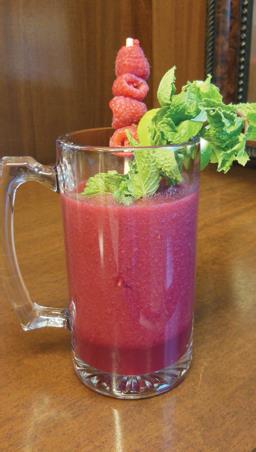I want to tell you a story about one of the weirdest-looking trees I’ve ever seen. It grows in Africa and it’s called the baobab…

You can see how massive the baobab tree is in comparison to me and my Jeep.
Legend says it got its funny looks because it refused to stay where God put it. It kept popping up in random places — anywhere except where it supposed to be.
So God pulled it out of the ground. And planted it upside down in order to keep it quiet.
What’s even more amazing than that is the fruit that comes from this strange-looking “tree of life…”
Nicknamed the “monkey bread tree” because monkeys love to eat its sweet mushy pulp, the baobab is one of the most powerful secrets to a healthy gut microbiome on the planet.
Now, you hear a lot about probiotics and their effect on your gut — your most important organ…
But you hear almost nothing about pre-biotics.
You know that probiotics are the “good” bacteria that protect your microbiome — crowding out the bad bacteria. An unbalanced gut biome full of harmful bacteria leads to a wide range of health problems including autoimmune diseases, thyroid disorders, diabetes, obesity and cancer — as well as gastrointestinal disorders like Crohn’s disease and irritable bowel syndrome.
Prebiotics are a special kind of non-digestible fiber. These living microorganisms pass through your gut and remain undigested because your body can’t break them down.
In other words, prebiotics act like fertilizer — feeding your probiotics so they can do their job.
Our ancestors ate a primal diet that kept their guts in perfect balance. Today, we need both to add prebiotics to our diet in order to:
- Balance your gut pH. Prebiotics reduce the amount of pH in your intestinal lining. This makes the gut more acidic and less welcoming to bad bacteria. And the more acidic your gut, the less likely you are to have digestive disorders like irritable bowel syndrome, heartburn, constipation and diarrhea.
- Reduce inflammation. A recent review of more than 20 studies found that prebiotics can lower C-reactive protein. This dangerous inflammatory marker is linked to heart disease, cancer, diabetes, obesity and more.1
- Fight colon cancer. Prebiotics increase a stomach acid called butyrate. Compelling new research shows that this acid causes colon cancer tumors to self-destruct!2 Butyrate is also a powerful weapon against disorders of the brain such as depression, stress, anxiety — and even Parkinson’s disease.
- Protect against diabetes. Scientists are just beginning to understand that people with diabetes have fewer prebiotic microflora in their gut. And that raising levels can be a powerful treatment for the disease. A recent study found that after five weeks of taking prebiotic supplements, patients had major improvements in blood sugar levels and insulin resistance. The same showed that prebiotics can reduce insulin sensitivity by up to 300%.3
- Increase nutrient absorption. Nearly 90% of nutrient absorption takes place in the gut. And prebiotics strengthen the gut, allowing more nutrients to be taken in by the body. In one study of 100 people, participants who took a daily prebiotic supplement absorbed almost 9 times more calcium within eight weeks than those taking a placebo.4
- Prevent leaky gut. Prebiotics help strengthen your intestinal wall. This prevents leaky gut syndrome — a condition in which toxins penetrate the thin intestinal lining causing a range of health problems, like allergies and autoimmune diseases.
- Speed up weight loss. A balanced gut helps you feel fuller longer… speeding up weight loss. A recent animal study of mice at the University of Utah showed that after five weeks of being given prebiotic supplements, mice lost an amazing 10% of their body weight.5
As you can see, your microbiome is key to your good health. And with more than 50% of the prebiotic fiber you need every day, baobab fruit is one of the best things you can do to feed and protect your probiotics to help your gut stay in balance.
Baobab has a unique, sweet taste. The raw food isn’t common in this country yet. I’ve seen it occasionally at Whole Foods Market. But it’s much easier to find powder or supplements. I recommend taking 20 mg a day.
Nourish Your Probiotics with My Red Baobab Drink Recipe
In Africa, locals add dried baobab to ice cream and even put it into soups and sauces. I like adding a scoop to my Red Drink recipe. It adds a creamy melon-like tang to the smoothie. Here’s how I make it:

Ingredients:
- 1 whole lime, peeled
- 1 whole red beet
- ¼ cup of cilantro
- 4 heads of broccoli with stems
- 1 peeled Florida navel orange
- Tiny piece of turmeric
- ¼ cup of coconut water
- ¼ cup of filtered tap water
- ¼ cup of spinach
- ¼ cup of arugula
- 6 stalks of dandelion greens
- 4 baby carrots
- 2 Tbsp. baobab powder
- ½ cup of ice
Blend all the ingredients together and enjoy.
To Your Good Health,
![]()
Al Sears, MD, CNS
References:
1. Mazidi M. “Impact of probiotic administration on serum C-reactive protein concentrations: Systematic review and meta-analysis of randomized control trials.” Nutrients. 2017;9(1):20.
2. Canani RB, et al. “Potential beneficial effects of butyrate in intestinal and extraintestinal diseases.” World J Gastroenterol. 2011;17(12):1519–1528.
3. Gao Z, et al. “Butyrate improves insulin sensitivity and increases energy expenditure in mice.” Diabetes 2009;58(7):1509-1517.
4. Slavin J. “Fiber and prebiotics: Mechanisms and health benefits.” Nutrients. 2013;5(4):1417-1435.
5. Gao Z, et al. “Butyrate improves insulin sensitivity and increases energy expenditure in mice.” Diabetes. 2009;58(7):1509-1517.

